
And again about hypertonicity.
One of the most important aspects regarding facial gymnastics is determining the tension in the muscles. Most people have difficulty trying to analyze the condition of their muscles.
There are usually no problems with the corrugator and frontalis muscles -
everyone sees folds on the forehead and bridge of the nose when they lower or raise their eyebrows.
But not everyone notices tension in the muscles of the nose, cheeks, chin and lips.
I receive many letters where people ask for help in determining whether hypo- or hypertonicity of their facial muscles has led to one or another fold on their face.
First, let's talk about lips.
I often encounter this problem: I tell a person who comes to my classes that the reason, for example, for his nasolabial folds or bumps above the corners of his mouth is that he constantly tenses his lips - and the person responds with disbelief, saying, it can’t be, I I don’t strain my lips, this is their normal state.
You can explain it “on your fingers” for a long time, but until you show a visual example, understanding usually does not come.
So let's look at the pictures:
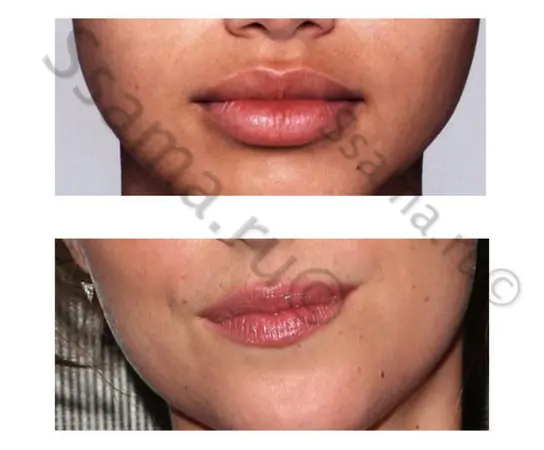
In the first photo above you can see relaxed lips.
In the second photo from above, the lips are tense.
I hope you see the difference.
Here you can object: these two people may have different ages, genetics, bite, etc., that is, it is incorrect to compare them. To show that this is not so, I tried to repeat on my own face the condition of the lips from the first two pictures:
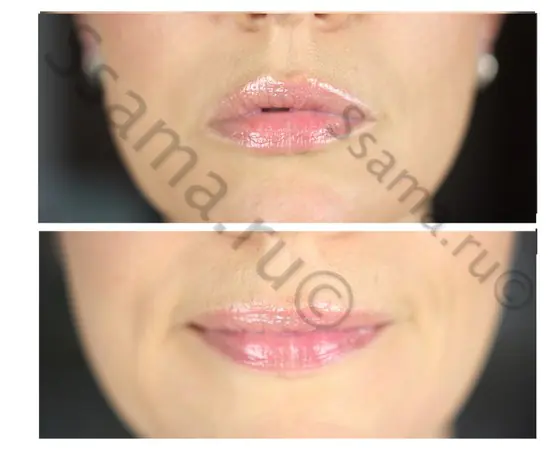
It looks different, of course, because the structure of my face is different from the women in the first photos, but the essence of the facial movements is the same. I hope you can see the difference between my first and second photo.
And now I will give examples of other ways we tense our lips throughout the day (note that all photos with tense lips show unevenness around the lips, unlike photos with relaxed lips):
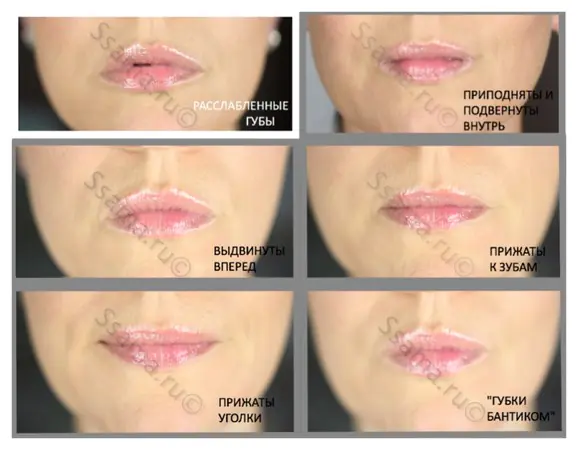
Most people DO NOT CONSIDER this slight tension in different areas of the muscles in the lip area as TENSION and believe that maintaining this condition of the lips throughout the day is normal and does not affect the aging of the face. But it is long-term tension of the lips that is the most common cause of nasolabial folds, ridges above the corners of the mouth, dips under the corners of the mouth, uneven chin and even “bulldog cheeks.”
Even a slight narrowing of the lips that is not noticeable to the eye, pulling them slightly forward, raising or pursing the corners of the mouth, pressing the lips against the teeth, lowering the upper or lower lip down, etc., etc. - all this leads to permanent tension in the muscles of the area lips and facial deformations in general.
Why do many people think that tense lips are normal?
The fact is that the everyday “mask” of the face, that is, what mood we express and wear on it most often, is laid down from childhood, and often the “mask” in the lip area depends on the bite, as well as psychological problems, fears and complexes . Therefore, people grow up with a certain most frequently used position of the lip muscles without noticing it. And only comparative photos by age or long-term observation of oneself helps one realize that lips can still be relaxed, that their “mask” can be changed.
To correct the situation with tense lips, at a minimum, you need to wean yourself from the bad habit of constantly straining your lips, and also at least sometimes do mini-warm-ups for your lips:
- lip smacking,
- lip-smacking with a slight twist of the lips inward, behind the teeth,
- tapping fingers flat on outstretched lips,
- articulation of all vowel sounds,
- “pump”: place your index fingers horizontally above the upper lip (fingertips at a distance of 1-2 cm from each other), and thumbs under the lower lip (similar to the index fingers), lightly press on the muscles under the fingers and release, at a fast pace, slightly more than once per second, 30-100 times. The movements are soft and springy. After execution, lips are fuller and more prominent.
It's very simple, isn't it?
Such daily work is no less important and no less effective than the facial gymnastics themselves.
A few words about the nose.
Very often, tension in the muscles of the nose and/or in the canine muscle leads to the formation of nasolabial folds, although tension in the above muscles is also not noticed by many.
Again I present 2 photos: a relaxed nose and a tense one.
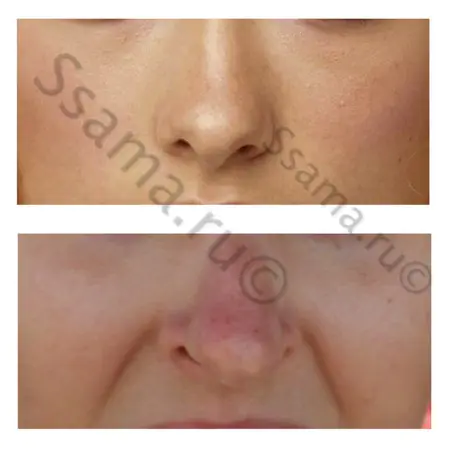
And again I repeat the position of the muscles of the first two photos on my face:
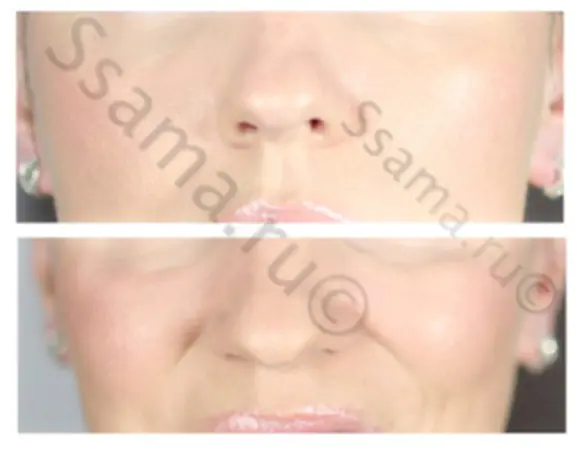
Observe yourself: are you tensing your nasal muscles or the canine muscle that raises the upper lip?
If the nasolabial fold is more pronounced at the wings of the nose than at the corners of the lips, then there is a possibility that you are straining it.
Try lightly pressing on the points on the sides of your nose for 5 seconds. Release your fingers, apply them again and vibrate for 5 seconds. If you feel a clear relief in the muscles, as if they were swollen and now suddenly move away a little, then there is a chance that you are tense your nose muscles unconsciously throughout the day.
To avoid the occurrence of nasolabial folds due to tension of the nasal muscles, you need to wean yourself from tensing your nasal muscles, that is, wean your face from a grinning, displeased or disgusted grimace (even if it is almost invisible), and also sometimes do the following simple manipulations:
- open your mouth, feel the canine muscle (see atlases of facial muscles) with medium-strength blotting movements, 5-10 times,
- vibrate the points on the side of the wings of the nose with your fingertips for 3-7 seconds, then with three fingers the lateral surface of the nose from the wings almost to the level of the bridge of the nose.
- lightly! 3 times for 3 seconds, stretch the muscles on the sides of the nose, left and right in turn, grabbing the muscle at points: just below the inner corner of the eye and just above the wing of the nose.
The most important thing: don't overdo it! The above effects should be a micro-shake for tense muscles, and not an hour-long massage and stretching with the likelihood of disastrous consequences from excessive zeal. Everything takes 1 minute, and everything is done very delicately!
Next time we’ll talk about tension in the muscles of the cheeks and chin, as well as the chewing muscle.
Bartsok-gymnastics course for the face
Why does the face look older? Using specific examples, we master the technique of reducing chronic tension in the facial muscles and the resulting wrinkles on the face.
How, using facial muscles, we create wrinkles for ourselves.
We raise our eyebrows when we want to express surprise or disbelief. This works the frontalis muscle, one of the largest facial muscles. Like other facial muscles, the frontalis muscle contracts by creating temporary folds of skin. Some people were once surprised and forgot about it, continuing to walk around in surprise, not noticing the slight remaining tension in the facial muscles. But as people age, their skin's elasticity decreases and their forehead begins to resemble a washboard. But there are men who believe that it decorates them.
Women are more likely to appear frowning or angry. What makes them look like this is a vertical wrinkle on the forehead. You can accidentally move your eyebrows while concentrating on something, and you can often get angry with yourself. But why keep the tension in your face after that? Girls often do not pay attention to the tension of the small muscle that moves the eyebrows. But once the skin begins to lose its youthful elasticity, chronic tension of this muscle will lead to a permanent crease between the eyebrows.
A deepening of the nasolabial fold may be associated with almost imperceptible chronic tension of the upper lip. The upper lip rises up if a person wants to sneeze or cry, if he smells an unpleasant odor, or if his face reflects disbelief. If any of this happens frequently, the upper lip may remain slightly raised as usual.
The habit of squinting can lead to a permanently raised lower eyelid, stretching of the delicate skin of the lower eyelid, and then to wrinkles under the eyes. Constantly smiling will lead to tension in the facial muscles in the corners of the mouth or on the cheekbones, and then to crow's feet and a deepening of the nasolabial fold. And compressed lips will create conditions for the appearance of early wrinkles above the upper lip.
We are given facial muscles to instantly express our emotions. When emotions go away, complete relaxation of the facial muscles should occur, that is, even slight tension in the face should not persist for long. Such chronic tension of the facial muscles constantly pulls the skin, impairs blood circulation in it, creating conditions for accelerating its withering and sagging. These are habits that can be changed, and this is one of the main reasons for the formation of wrinkles. In addition, such habitual chronic tension of the facial muscles creates a feeling of tension in the face and accelerates the onset of fatigue. No new or proven cosmetic technology can help you change your habits. You can only eliminate this cause of accelerated aging of facial skin and the appearance of wrinkles on your own.
Reducing fatigue and wrinkles by eliminating habitual but unnecessary tension in the facial muscles.
Frederick Alexander came up with directives - mental orders that are given to the body to get rid of an unnecessary habit.
If you want to get rid of the habit of frowning when you are concentrating, squinting or wrinkling your forehead when remembering something, you need to give the appropriate order to your nervous system. Such an order should lead to a feeling of relaxation in the face, if the obedient nervous system relieves tension from the muscles. Let's try to do mental actions for some facial muscles, chronic tensions of which are especially common.
Fibers of six facial muscles are woven into the skin of the corners of the mouth. Try telling the corners of your mouth to move toward the center. You just need to order, and not move the corners of your mouth consciously. If any of the 4 facial muscles of the middle part of the face retain their usual tension, then when a mental order is carried out, these facial muscles will relax. In this case, you will feel a slight movement of the corners of your mouth towards the center, relaxation in the cheekbones and (or) cheeks and an increase in the plumpness of your lips. The nasolabial fold will also decrease somewhat.
The other two facial muscles approach the corners of the mouth from below. If the tension in these facial muscles remains, then mentally commanding your lips to move towards the center will lead to a feeling of facial relaxation in the area under the lower lip or on the neck, and the corners of your mouth will rise slightly.
Try to mentally pull your upper lip down. Imagine that you grabbed your upper lip with your fingers and pulled it down along the entire width of your lip. You may feel relaxation in your facial muscles around your upper lip, the sides of your nose, or under your eyes. This means that your levator labii muscle was slightly strained. Feeling your face relax, you may also feel some smoothing of the nasolabial fold.
Perhaps you squint often. Then, to remove tension in your face, you need to mentally pull down your lower eyelids. Squinting occurs due to the contraction of the facial muscle, the orbicularis oculi muscle, which moves the skin towards the centers of the eyes. When the tension in the orbicularis oculi muscle is released, you will feel that your eyes have become larger.
If you have a tendency to form a vertical crease on your forehead or a horizontal crease on the bridge of your nose, try mentally pulling the ends of your eyebrows to the sides. Most likely, the facial muscles in the bridge of the nose will relax, the skin here will rise slightly, and wrinkles will decrease.
Horizontal wrinkles on the forehead, on the contrary, indicate that the skin of the forehead is already slightly raised. In this case, you need to mentally grab your eyebrows with your fingers and pull them down. The eyebrows will lower slightly, you will feel a relaxation of your face on your forehead and under your eyes, and wrinkles will decrease slightly.
You may have a habit of pursing your lips. This can lead to chronic tension in the chin muscle, and possibly a slight contraction of another facial muscle, the orbicularis oris muscle. This habit is facilitated by another bad habit - clenching your teeth, which it would also be nice to get rid of. If you have such tension in your face, then you should feel the relaxation of the facial muscles in the chin area, mentally pulling your lower lip down.
You have probably now been able to relieve some accumulated tension in your facial muscles. But they will appear again and again until you train your face to behave differently. This “other” means that the facial muscles must tense on the face just to reflect your emotions. Learn to first notice the relaxation of your face when emotions go away, so that this relaxation becomes a new habit and becomes automatic.
Learn to quickly relieve the habitual chronic tension in your facial muscles that you have found. When the face gets used to mental orders, it will not take much time: 2-3 seconds are required to relieve tension from all the muscles suspected of this in turn, if you mentally walk over the face from top to bottom. At first, check often to see if tension in your face has returned. And, gradually, it will stop appearing.
To relax your facial muscles, you can also use the quick complex “Set of instant exercises to relax your facial muscles”
or its audio version.
If mastering this training has caused difficulties and you need help, write us a letter or take a video lesson from a master via Skype, indicating your problem.
A slight chronic tension, depending on your habits, can remain in any facial muscle. The best way to learn to feel and relieve such facial muscle tension is to master exercises for all facial muscles. This is all the more important because all facial muscles must be strong, not sag and not create wrinkles.

- December 15, 2018
- Health
- Natalie M
The facial muscles are quite mobile. Every day a person experiences a huge variety of different emotions: surprise, anger, joy, disappointment. Moreover, they are all displayed on the face. Constant work and movement of muscles leads to the formation of unpleasant facial wrinkles. Even in ancient times, many people could determine a person's character by looking at their face. Folds on the forehead indicated that the person often frowns, which means that, most likely, he is dissatisfied with something in life. The downturned corners of the lips also indicated a fairly frequent pessimistic mood. But small wrinkles near the eyes, on the contrary, spoke of a cheerful disposition. This illustrative example shows how closely the emotional state of people is connected with their physical body. This is why relaxing the muscles on the face is very important for their natural functioning. It will be very useful to relax them with the help of special exercises. Below you will learn how to relax your facial muscles.
Causes of facial muscle tension
Since a person’s facial muscles work throughout the day, by the evening they need rest. However, not everyone knows how to relax them. Over time, the facial muscles get used to such tension and are no longer able to relax on their own. They can be in such a state even when a person is completely calm and does not experience any emotions. Prolonged muscle tension on the face causes spasms, a feeling of tightness of the skin in the forehead, as well as tightness of the face. Because of this, blood circulation deteriorates, the skin on the face becomes flabby, duller, takes on an unhealthy shade, and becomes covered with wrinkles.
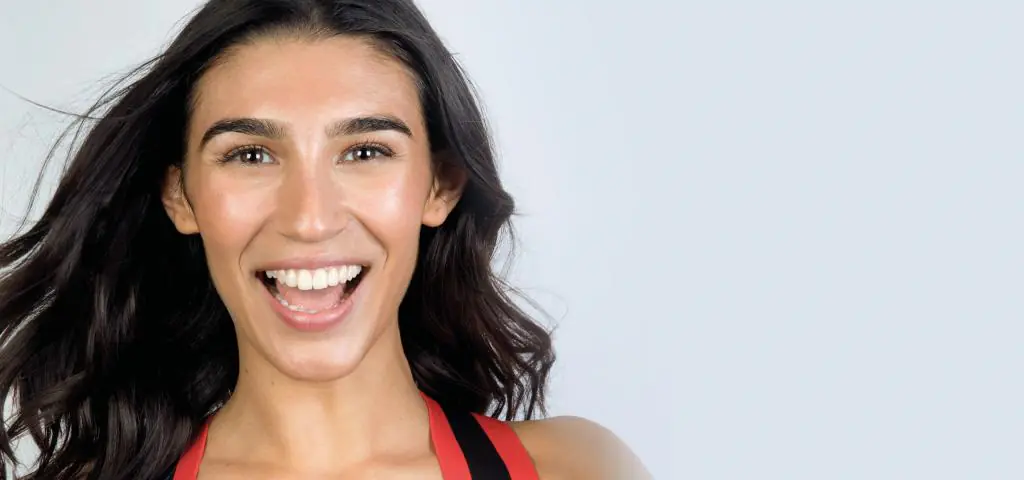
Wrinkles, which are caused by fatigue of the facial muscle tissues, are localized in the corners of the eye area, as well as on the forehead. In addition, a person’s nasolabial folds increase, their cheeks begin to sag and the entire texture of their face changes. As a rule, having seen such unpleasant changes on their faces, representatives of the fair sex, and some men, try to somehow save the situation with the help of cosmetics. However, unfortunately, no expensive cosmetics can cope with fatigue of the facial muscles. Only special gymnastics aimed at relaxing muscles and massage can help here. We'll talk about how to relax your facial muscles in the next section.
The main reasons that cause facial muscle tension are:
- the habit of often frowning the muscles on the forehead;
- habit of chewing food on only one side;
- malocclusion since birth;
- habit of constantly sleeping on only one side.
Exercises to relax facial muscles
There are very simple exercises that are aimed at working the muscles on the cheeks, cheekbones, and forehead. Doing them daily helps relieve tension, reduce wrinkles, increase blood circulation, improve complexion and make the skin more elastic. Before describing how to relax your facial muscles, it should be noted that the exercises are suitable for both women and men. It is extremely important to do gymnastics in a calm, maximally relaxed state, while breathing should be deep and slow. After each such exercise, a feeling of relaxation should appear in the area of the muscle being worked. Before starting gymnastics, you need to take the most comfortable and convenient position.
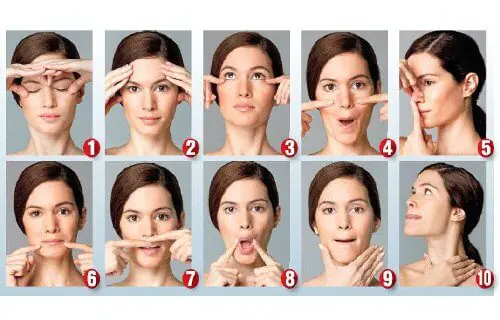
Gymnastics for the cheeks
How to relax the facial muscles on the cheeks? To do this you will need to perform the following exercises:
- Close your eyes, take a deep breath and try to raise your eyebrows as high as possible. You need to stay in this position for several seconds, then you need to exhale, and finally lower your eyebrows. Rest for a few minutes and repeat this exercise again.
- Take a deep breath and try to tense the wings of your nose as much as possible (as if flaring your nostrils), then exhale and relax. You need to do this exercise several times in a row.
- How to relax the facial muscles in the cheek area? Open your mouth slightly and lift one corner of it higher to create a “crooked” smile. You need to stay in this position for a few seconds and then relax your muscles. Then repeat the same exercise with the other corner of your mouth.
- You need to alternately blink first with one eye, then with the other, while feeling how the muscles on your cheeks stretch higher.
- Try to wrinkle your face as much as possible. You should stay in this position for a couple of seconds, after which you need to relax.
- Grasp your upper lip with your fingers and very smoothly pull it down. Without letting go of your lips, try to smile and feel how your cheeks tense while doing this.
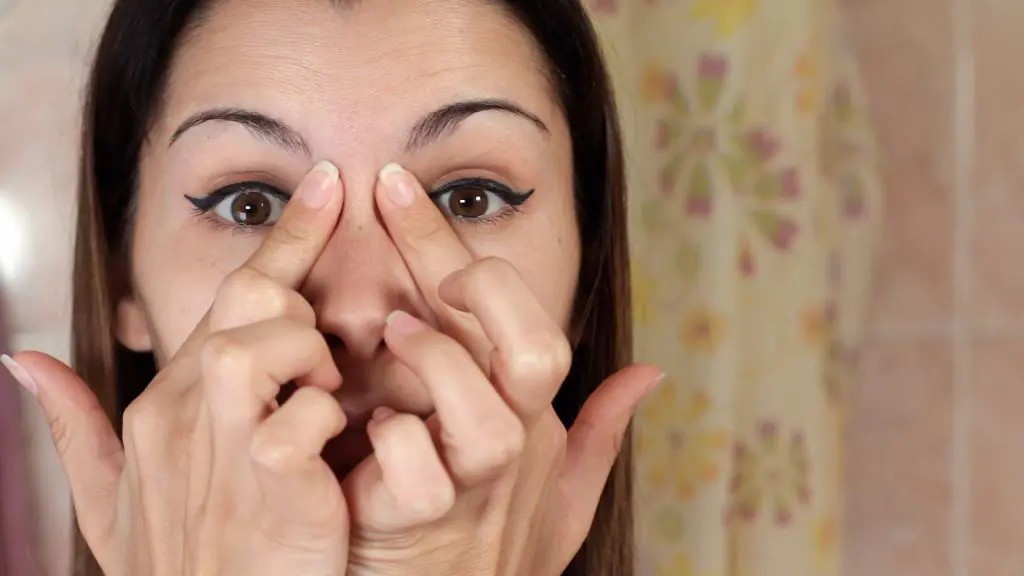
Gymnastics for the muscles around the eyes
We continue to consider exercises to relax the facial muscles. How to relax the muscles around the eyes?
- Take a deep breath, close your eyes. Gradually tense your eye muscles and then close your eyes. Hold them in this tension for several seconds, then exhale and relax. Repeat this exercise.
- Make circular movements with your eyes, initially clockwise, and then in the opposite direction (3-5 movements each). The head should remain motionless during the exercise.
- It is necessary to position your head straight and look forward. Without changing the position of your head, direct your gaze upward, pause for a second, and then lower it down. Repeat the exercise.
- Place your head straight and keep your gaze in front of you. After this, without turning your head, direct your gaze initially in one direction and then in the other. Repeat the exercise 3-5 times.
- Close your eyes tightly, hold this position for 5 seconds, then try to relax. Do the exercise 10 times.

Gymnastics for the mouth muscles
How to relax the facial muscles near the mouth? To do this, do the following exercises:
- Bring your lips together and blow a kiss. Repeat the movement 3-5 times.
- Stretching your lips as much as possible and at the same time rounding your lips, make the sounds “oo-oo-oo”, “ah-ah-ah”, “o-o-o”, “uh-uh”, “y-y-y” ", "and-and-and."
- Open your mouth slightly and try to turn your lips inward. Hold the tension for about a couple of seconds, then relax the muscles. Repeat this exercise several times.
- How else can you relax the chewing muscles of your face? With your lips closed, try to smile first with one side of your mouth and then with the other. Then smile both sides at the same time. Do this exercise several times.
- Open your mouth slightly and pull one corner of it to the side more strongly, then repeat the same movement with the other corner of your mouth.
- Place the index fingers of both hands on the corners of your mouth and smile, while creating resistance with your fingers. Relax. Repeat this exercise 20 times.
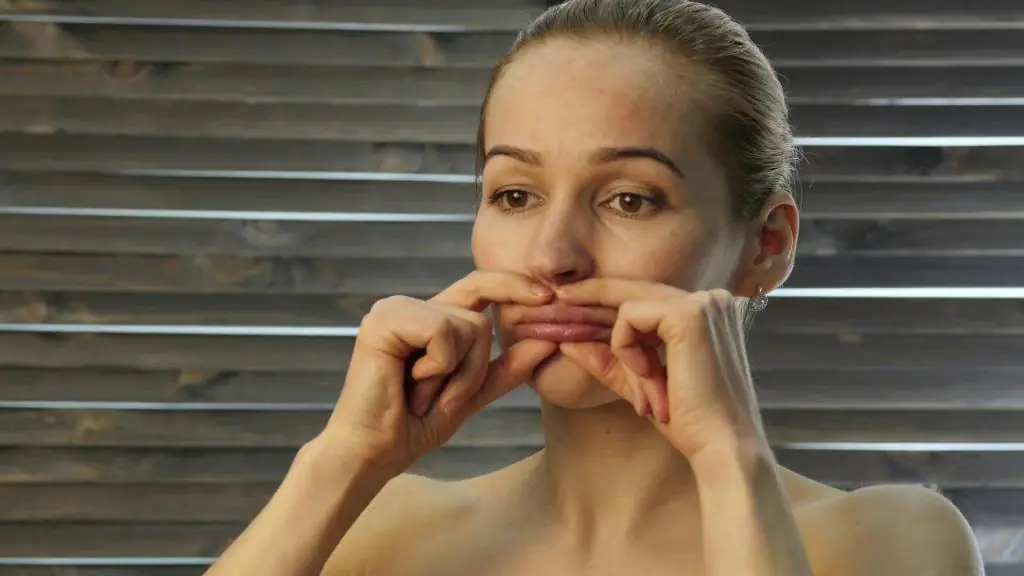
Gymnastics for the muscles of the neck and chin
A relaxed face should be everywhere. Below are some exercises to relax the muscles on the neck and chin:
- Tilt your head back and open your mouth. Without changing this head position, open and close it.
- Tuck your upper and lower lips inward. Tighten the muscles in your chin and neck and open and close your mouth.
- Tighten your neck muscles, then slowly pull your neck up, then return to the starting position. Repeat this exercise.
- Tighten your neck muscles. Smoothly and slowly turn your head from one side to the other, making sure that your neck remains tense.
- Place your palm on your forehead and try to tilt your head while applying resistance with that hand. Repeat the same with the back of your head, but now you need to tilt your head back, resisting its movement with your palm.
Massage for relaxation
If you don't know how to relax your face, you can also do a massage.
Facial massage is a great way to relieve tension. In addition, it perfectly helps to relax the muscles on the face and has a beneficial effect on the skin. Massage can be performed in the evening before bed, and it is good for the fair sex to do this procedure in the morning before applying makeup. Before starting a massage, you must cleanse your skin (wash, then remove makeup), apply a moisturizing or not too greasy nourishing cream on top.
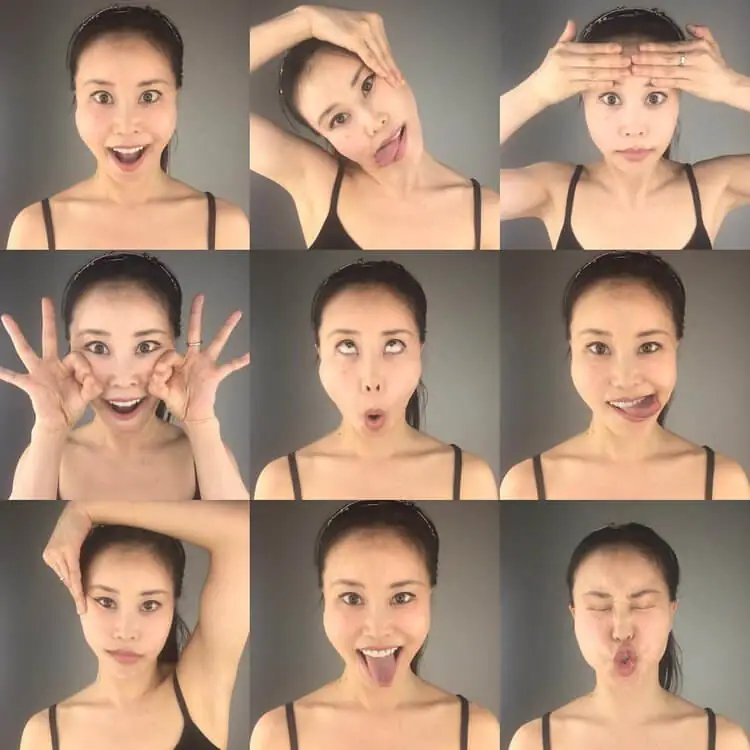
Basic massage process
It is recommended to start the massage from the forehead area, lightly pressing on the area between the eyebrows and gently running your fingertips along the line from the bridge of the nose higher to the forehead. A massage on the scalp helps relieve tension in the forehead area. It is necessary to press your fingertips to your head, then begin to knead the skin from the forehead in a circular motion, smoothly moving to the back of the head, not forgetting about the sides.
Then you can move on to eyebrow massage. Eyebrows should be massaged with soft and smooth movements, starting from the bridge of the nose and ending with the temples. You can grab the skin of the eyebrows and upper eyelid with your fingers, then gently pinch it.
The skin around the eyes is very delicate. Therefore, you should massage it carefully. First you need to pay attention to the corners of the eyes, then gently stretch the area under the lower eyelid.
The cheekbone area should be massaged towards the temples. In this case, there is no need to press hard on the skin; you need to make light tapping movements with your fingertips. Having found a tense area, you need to pay special attention to it: pressing lightly, massage it gently in a circular motion. The temple muscles should also be massaged.
Massage of the muscles near the mouth is carried out by pressing on the area above the upper lip, heading towards the corners of the mouth. Then you should massage the point, which is located in the center, directly under the lower lip. To eliminate sagging chin muscles, you need to gently pat the lower area of the chin with the back of your hand.
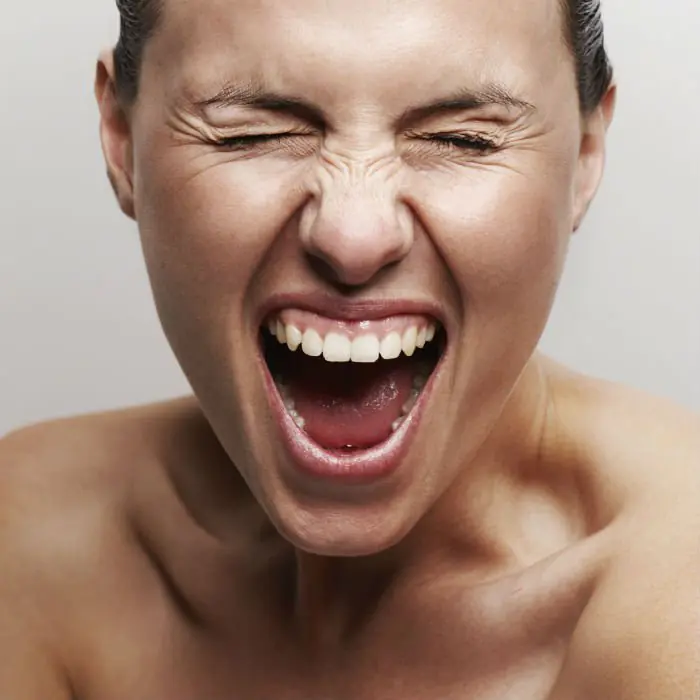
You need to walk with gentle patting movements over the entire surface of your face until you feel warmth and a slight tingling sensation. This will enhance relaxation.
Completion of the massage
When finishing the massage, you should once again carefully feel all the muscles of the face to find areas where there is slight tension. If they are present, you need to lightly massage them. Then you should cover your face with your palms and sit for about a minute. The massage is over.
Conclusion
Regular exercises and massage help not only relieve muscle tension, but also preserve the youth and beauty of your facial skin for a long time. They are very simple and anyone can make them themselves at home.



